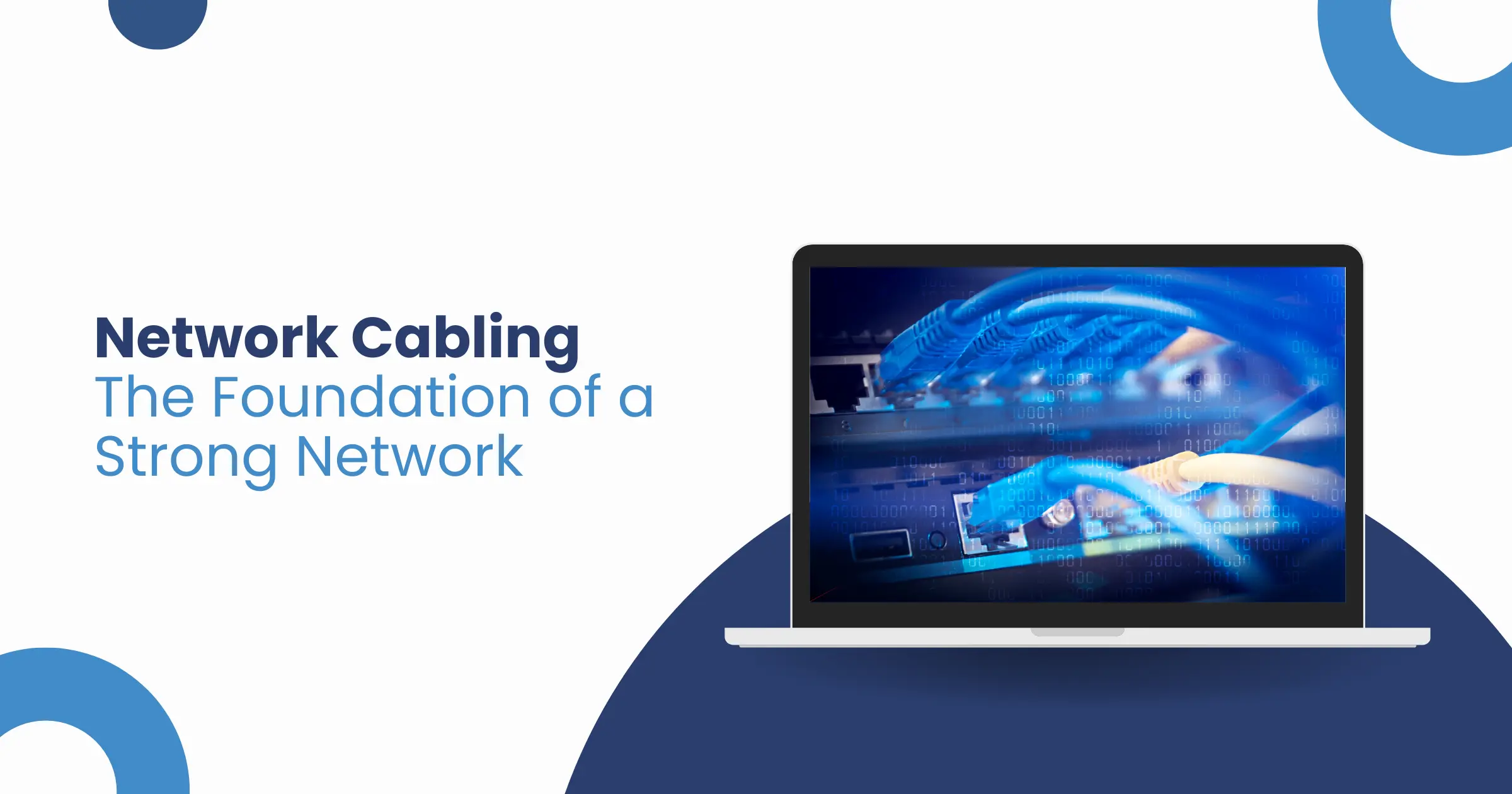In today’s digital age, a reliable network is the backbone of any business or organization. Whether you’re connecting computers, phones, or other devices, a well-designed network cabling infrastructure is essential for smooth operation and optimal data flow. This blog post dives deep into the world of network cabling, providing you with the knowledge you need to make informed decisions about your network’s foundation.
Network Cable Types
There are several types of network cables used for data transmission, each with its own advantages and limitations:
- Coaxial Cable: Traditionally used for cable TV and early Ethernet networks, coaxial cables consist of a single insulated wire surrounded by a braided metal shield. While less common today, they can be suitable for short-distance connections.
- Unshielded Twisted Pair (UTP): The most widely used type of network cable, UTP features four pairs of color-coded wires twisted together. This twisting helps reduce crosstalk, which is interference between neighboring cables. UTP comes in various categories, with Cat5e and Cat6 being the most common for modern networks.
- Shielded Twisted Pair (STP): Similar to UTP but with an additional foil or braided shield around each twisted pair, STP offers superior protection against interference. It’s often used in environments with high electromagnetic noise, such as factories or data centers.
- Fiber Optic Cable: Utilizing light pulses for data transmission, fiber optic cables offer the highest bandwidth and are ideal for long-distance connections or applications requiring maximum speed and security.

Choosing the Right Network Cable
The ideal network cable for your needs depends on several factors:
- Data Transfer Speed: Cat5e cables support speeds up to 1Gbps, while Cat6 can handle up to 10Gbps. Fiber optic cables offer significantly higher speeds, perfect for high-bandwidth applications.
- Distance: UTP cables generally have shorter maximum lengths compared to fiber optic cables. For longer distances, fiber optics are the clear choice.
- Interference: If your environment has a lot of electrical noise, consider using STP cables for added protection.
Network Cable Specifications (Cat5, Cat5e, Cat6, Cat6a)
Network cable categories define the performance specifications, including maximum data transfer rates and supported frequencies. Here’s a breakdown of common categories:
- Cat5: Supports up to 100Mbps data transfer speeds at 100MHz.
- Cat5e: An enhanced version of Cat5, offering improved performance with support for up to 1Gbps speeds at 100MHz. (This is the most widely used category for modern networks.)
- Cat6: Designed for Gigabit Ethernet networks, Cat6 supports speeds of up to 10Gbps at 250MHz.
- Cat6a: An improved version of Cat6, Cat6a offers better performance and reduces crosstalk at higher frequencies (up to 500MHz).
Network Cable Length Limitations
Each network cable category has a recommended maximum length for optimal performance. Exceeding these lengths can lead to signal degradation and network issues. Here’s a general guideline:
- Cat5/Cat5e: Up to 100 meters (328 feet)
- Cat6: Up to 55 meters (180 feet) for 10Gbps speeds (longer lengths supported for lower speeds)
- Cat6a: Up to 100 meters (328 feet) for 10Gbps speeds
Network Cable Connectors (RJ-45)
The standard connector for network cables is the RJ-45 (Registered Jack 45). These connectors have eight pins that follow specific wiring schemes (T-568A or T-568B) to ensure proper data transmission. Network cabling services [insert keyword variation – network cable installation] can handle the termination of cables with RJ-45 connectors according to industry standards.
Making Your Own Network Cables
While it’s possible to make your own network cables, it requires specialized tools and knowledge of proper termination techniques. For critical network applications, it’s generally recommended to use pre-made, certified cables or consider professional network cabling services [insert keyword variation – network wiring service] to ensure optimal performance and reliability.
Network Cable Testing and Troubleshooting
Testing your network cables is crucial to identify any potential issues that might affect network performance. Cable testers can verify connectivity, cable length, and signal quality. If you’re experiencing network problems, troubleshooting your cables should be one of the first steps.
Network Cabling Best Practices
Here are some key practices to follow for a robust and efficient network cabling system:
- Cable Routing: Plan your cable runs carefully. Avoid running network cables parallel to power cables to minimize electromagnetic interference (EMI) that can disrupt signals. Maintain a safe distance between them whenever possible.
- Cable Management: Use cable trays, conduits, or other organizers to keep cables neat, prevent tangles, and improve airflow. This also simplifies future maintenance and troubleshooting.
- Labeling: Clearly label both ends of each cable and the corresponding port on patch panels or wall jacks. This makes identification and troubleshooting significantly easier, especially in complex network setups.
- Support and Strain Relief: Avoid placing excessive strain on cables by using cable ties or straps to secure them at regular intervals, particularly near connection points. This prevents damage from pulling or snags.
- Minimum Bend Radius: Don’t bend cables sharply, as this can damage the internal wires and affect signal quality. Follow the recommended minimum bend radius for your specific cable category.
- Spare Cables: Consider installing a few extra cables during initial setup. This provides flexibility for future network expansion or unforeseen needs without the hassle of rerouting new cables later.
Securing Your Network Cables
Network security is paramount. Physically secure your network cables to prevent unauthorized access. This might involve using lockable patch panels, wall plates, or cabinets to restrict access to sensitive network connections.
Common Network Cabling Mistakes to Avoid
Here are some common mistakes to be aware of when working with network cabling:
- Using Low-Quality Cables: Invest in high-quality cables from reputable brands. Cheap, poorly made cables can lead to signal degradation, network issues, and increased maintenance costs in the long run.
- Incorrect Cable Termination: Improper termination of RJ-45 connectors can cause connection problems and network instability. If you’re not comfortable with the process, consider using pre-made cables or professional network cabling services.
- Overstuffing Cable Trays: Avoid overloading cable trays or conduits. This can restrict airflow, damage cables from overheating, and make it difficult to manage and troubleshoot them in the future.
- Running Cables Through Walls or Ceilings: Unless properly installed and protected within conduits, avoid running network cables through walls or ceilings. This can make future maintenance and upgrades more challenging.
The Benefits of Structured Cabling Systems
A structured cabling system is a standardized approach to network cabling infrastructure. It offers several advantages:
- Scalability: Easily add new devices or workstations by utilizing existing cabling infrastructure.
- Flexibility: Structured cabling allows for modifications and reconfigurations as your network needs evolve.
- Reliability: Standardized components and installation practices ensure consistent performance and minimize connection issues.
- Maintainability: Organized and labeled cabling makes troubleshooting and maintenance significantly easier.
- Cost-Effectiveness: Structured cabling can save money in the long run by reducing the need for frequent cable replacements or troubleshooting due to poorly planned installations.
Network Cabling for Voice over IP (VoIP)
VoIP phone systems rely on a robust network infrastructure. When planning your network cabling for VoIP, ensure you’re using cable categories that support the necessary bandwidth for voice traffic. Consider using PoE (Power over Ethernet) technology to deliver both data and power to VoIP phones through a single cable, simplifying installation and reducing power supply needs.
Network Cabling for Wireless Networks
Even in wireless network environments, proper network cabling plays a crucial role. Wireless access points need to be connected to the wired network backbone for data transmission. Ensure you have sufficient cabling to connect all access points strategically throughout your space for optimal wireless coverage.
Future-Proofing Your Network Cabling Infrastructure
As technology advances and network demands increase, consider future-proofing your cabling infrastructure. Installing Cat6a or even fiber optic cables can provide headroom for future network upgrades and support higher bandwidth applications without the need for rewiring in the future.
Network Cabling Tools and Equipment
There are various tools and equipment helpful for network cabling projects:
- Cable Tester: Verifies cable connectivity, length, and signal quality.
- Cable Crimper: Used to properly terminate network cables with RJ-45 connectors.
- Punch Down Tool: Punches down wires onto patch panels or wall jacks according to the chosen wiring scheme.
- Cable Stripper: Removes the outer jacket of network cables for connector termination.
- Cable Ties and Straps: Organize and secure network cables to prevent tangles and strain.
- Cable Trays and Conduits: Manage and protect network cables during installation.
- Label Maker: Create clear and durable labels for cables and patch panels.














